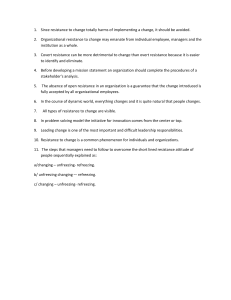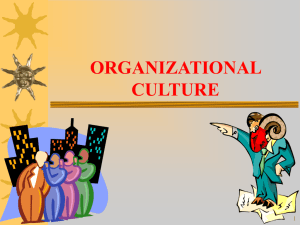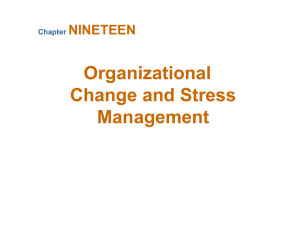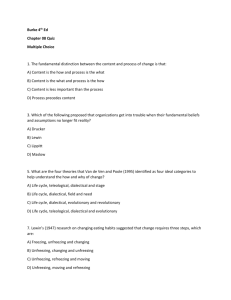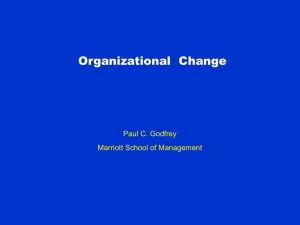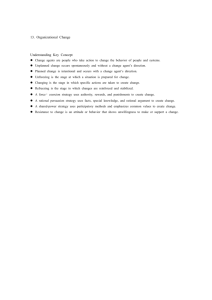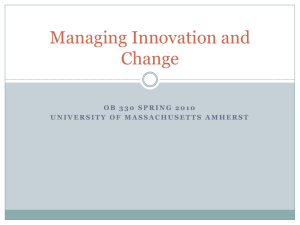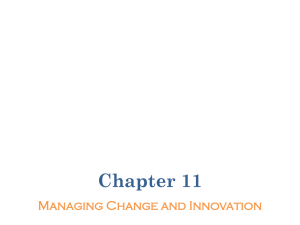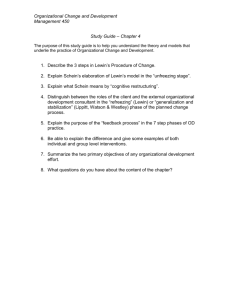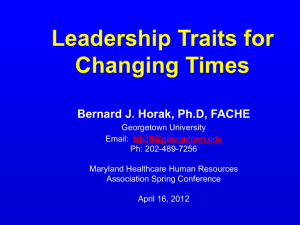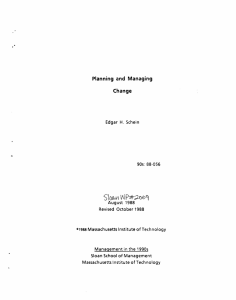The Symbolic Frame
advertisement
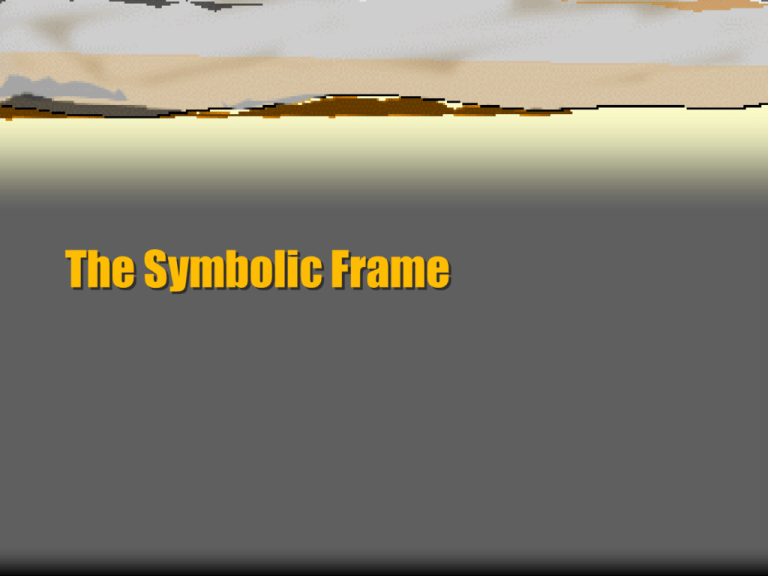
The Symbolic Frame Organizational Culture Defined The systems of shared beliefs and values that develops within an organization. In simple terms, organizational culture is the personality of the organization. Components of Organizational Culture Organizational Artifacts Cultural routines that form the substance of public functions and events staged by the organization. – Symbolism of Rites, Rituals, and Ceremonies Rites are relatively dramatic, planned sets of recurring activities used at special times to influence the behavior and understanding of organizational members. Components of Organizational Culture Organizational Artifacts (cont.). Language systems and metaphors. – The way that organizational members typically express themselves and communicate with each other. Stories, sagas, myths. – Stories are accounts based on true events; they often contain both truth and fiction. – Myths are beliefs that are accepted uncritically and used to justify current actions. The Impact of Culture on Organizations Strong cultures. Shared values and beliefs create a setting in which people are committed to one another and share an overriding sense of mission. A strong culture can cause a resistance to change, however, by reinforcing a singular view of the organization and the environment. Information Technology: The Impact on Culture and Change Information technology removes barriers of time, distance, communications and in some cases, organizational level The removal of these barriers has caused employees to be less tolerant of ivory-tower management This trend has facilitated employee empowerment and flatter organizational structures Shlain, The Alphabet Versus the Goddess “Major neuronal pathways such as the instinctual instructions that automatically inform all other mammals how to survive at birth disappeared. To compensate, the missing pieces of the hominid neonatal brain were added after . . . Much later we would name these ‘culture’”. Culture Tells Us: What we need to know to survive in an organization How it is communicated in the Organization Organizational Culture What we need to Know. Basic Underlying Assumptions Espoused Values How It is Communicated. Artifacts Physical Layout Decorations Slogans Stories Rites & Ceremonies Organizational Culture Individual Behaviors Influences Perceptions, Defines Reality, Defines Situation Guidelines for Behavior Common Identity Organizational Effectiveness Kotter & Heskett Strong Culture Effective if Matches Environment Strong Cultures Must Value Change Must Value EE’s, Customers & Stockholders Changing an Organization’s Culture Top managers can set the tone for a culture and for culture change Managers who strive for quality understand they must involve employees , build on what organizational members share, and teach new members how to behave The Challenge to Understanding Organizational Change Change is essential to an organization’s survival Is it important that organizations recognize the need for change and learn to manage the process effectively Organizational Change Organizational change is any alteration of activities in an organization Examples of areas in which organizational change can occur: Structure of the organization Transfer of work tasks Introduction of a new product, service or technology Targets for Change Individual Targets Involves human resource changes. Changes in this area are triggered by new staffing strategies or by an effort to enhance workforce diversity. Group Targets Involves changes in the nature of the relationship between managers and subordinates or the relationships within work groups. Targets for Change Organizational Targets Involves changes in any of the following areas: – Basic goals and strategies of the organization – Products, quality, or services offered – Organizational structure – Organizational processes such as reward, communication, or information processing system – Culture Targets for Change Environmental Targets Involves changing sectors of an organization’s environment. For example, changes in products or services offered may require new technology or a new distribution system. A Framework for Change Force Field Analysis Proposed by Kurt Lewin Describes change as a three-step process Unfreezing Changing Refreezing Unfreezing Step 1: Unfreezing Developing an initial awareness of the need for change and the forces supporting and resisting change. Unfreezing Driving forces Restraining forces Overcoming resistance to change Unfreezing Strategies for Unfreezing Change processes must overcome resistance to change. Strategies for dealing with resistance to change – Communication and education – Participation and involvement – Facilitation and support – Negotiation and agreement Unfreezing Strategies for Unfreezing Strategies for dealing with resistance to change (cont.) – Manipulation and co-optation – Explicit and implicit coercion Changing Step 2: Changing The second step in the change process focuses on learning new required behaviors Changing Organizational development activities: - Survey feedback - Team building - Process consultation - Quality-of-work-life programs Changing Tactics for planned change Organizational Development (OD) – A process of planned change that uses behavioral science knowledge, theory, and technology to help an organization improve its capacity for effective change. Changing Tactics for planned change (cont.) Techniques for people-focused organizational change : – Survey feedback - improve relationships among the members of groups or between departments through the discussion of common problems. – Team building - a process by which members of a work group diagnose how they work together and plan changes to improve their effectiveness. Changing Tactics for planned change Techniques for people-focused organizational change (cont.) – Process consultation - involves structured activities directed toward key “processes” through which members of a group work with one another. Changing Tactics for planned change Techniques for people-focused organizational change (cont.) – Quality-of-work-life Programs - Undertaken by an organization for the purpose of (1) improving the quality of employee’s work life, or (2) improving group or organizational productivity. Refreezing the Change Step 3: Refreezing The third step in the change process, centers on reinforcing new behaviors, usually by positive results, feelings of accomplishment, or rewards from others. Refreezing Gain top management support Reinforce new behaviors Evaluate results Refreezing the Change Approaches used to accomplish refreezing Gain top management support Reinforce new behaviors Evaluate the change Ethical Issues in Organizational Change Do employees feel manipulated? Does the CEO have a vested interest in the change? To what extent should the firm disclose all aspects of the change in advance? To what extent do employees have the right to participate in changes that affect them? Activities Associated with Effective Change Solicit input from those who will be affected by organizational change. Involvement is essential to accept the need for change Carefully formulate your message regarding the need for and nature of organizational change. The success of the change process will depend on effective communication Activities Associated with Effective Change Assess your organizational environment and be sure that the tone and the tempo of the change fit the organization. Timing is everything Serve as a role model for the behaviors sought by the organizational change. Actions speak louder than words Structure as Theater The symbolic view approaches structure as stage design: an arrangement of space, lighting, props, and costumes that make the drama vivid and credible to its audience. One role is to reflect and convey prevailing social values and myths. Leading Principles How someone becomes a group member is important Diversity provides a team’s competitive advantage Example, not command, holds a team together A specialized language fosters cohesion and commitment Leading Principles Stories carry history and values and reinforce group identity. Humor and play reduce tension and encourage creativity Ritual and ceremony lift spirits and reinforce values Informal cultural players make contributions disproportionate to their formal roles Leading Principles Soul is the secret of success.
